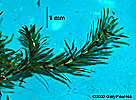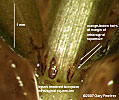
Invasive Plants of Wisconsin
| Hydrilla verticillata (L.f.) Royle hydrilla Family: Hydrocharitaceae |
||||||
|
||||||
|
Hydrilla verticillata is an aquatic species, usually growing submersed, or with the growing tips of stems floating on the surface. The leaves are simple, 18-15 mm long, 1.3 -4 mm wide and are whorled on the stem with often 4 to 6 leaves at each node. It is similar to our Elodea canadensis (Canadian water-weed) and Elodea nuttallii (slender water-weed) and also to Egeria densa (Brazilian waterweed), all of which are in the same family and have the same general habit and whorled leaves. Egeria is not yet known from Wisconsin, but seems a likely candidate to invade in the future. Elodea canadensis (and the less common E. nuttallii) usually have 3 leaves per node and Hydrilla and Egeria usually have more than 3 leaves per node. Hydrilla has conspiduous spines along the leaf margins and the other species are entire or very finely toothed, but not bearing spines. Hydrilla also has one or more spines along the midrib on the lower surface of some leaves and this character is unique within this group. The spines can be easily seen with a 10x hand lens, but I have been unsuccessful at taking a clear photo of them. However, the plants are extremely variable and spines may be few or absent on midribs of plants that are not thriving. A very small, but reliable character is the presence at the base of each leaf of tiny scales known as "intravaginal squamules" with orange brown hairs on their margins (see photo above). The intravaginal squamules of the other species in this group either lack marginal hairs or if they are present the hairs are not orange-brown. Hydrilla verticillata is a relatively new invasive species in the U.S.A. It is suspected of entering the country around 1960 and spreading quickly in the southeast. It is very recent in Wisconsin and it remains to be seen if it will persist through our winters. It apparently does not successfully reproduce by seed in the U.S., and persists by perennial growth in warmer areas, and by tubers produced below ground or on the stems. Fragments of broken stems can generate adventitious roots and continue to grow, providing a means of spreading quickly if the plants are broken into pieces and left in the water. |
|


